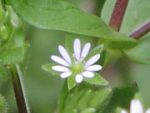
Mouse-ear chickweed is a mat-forming, cool-season perennial and a member of the pink family, Caryophyllaceae, that also includes carnations, baby’s breath, and soapwort. It is native to Eurasia but is widely naturalized around the world including the US where is grows in lawns, pastures, waste areas and woods throughout the country except in southernmost areas from Texas to California. An adaptable plant, mousear chickweed prefers shady moist sites but can tolerate wear, drought, and low mowing; its presence may indicate a compact moist soil.
Description: With a shallow fibrous root system, mouse-ear chickweed is a low growing plant with thin hairy stems that grow six the eighteen inches long. They spread at the base but turn up at the tips and root at the nodes when in contact with the soil. The oval to elliptical , one inch long leaves are dark to gray-green and are attached directly to the stem without petioles. The small white flowers appear in terminal clusters from spring to fall and have five petals that are notched at the tips and five green sepals the same length as the petals. The flowers give way to seed pods containing an abundance of seed so that a single plant can produce 10,000-15,000 seeds. Plants spread by both seeds and stem roots.
Control: The best way to rid a lawn of mouse-ear chickweed is to improve soil drainage and decrease shade. By watering a lawn deeply two to three times a week rather than daily the grass will develop deep roots that the mouse-ear chickweed can not and thus reduce the chickweed. Individual plants are easy to pull as plants are shallow rooted but care should to get as much as the root and plant as possible to reduce new sprouts. Plants can be cut down or mowed and then covered with a dense mulch such as cardboard or newspaper for one season. In all cases, the plants must be prevented from going to seed. In severe cases herbicides can be used and should be applied during the active growing season. Preemergence herbicides such as Dithiopyr and Isoxaben have proved effective as have post emergence herbicides such as 2,4-D, and Dicamba.